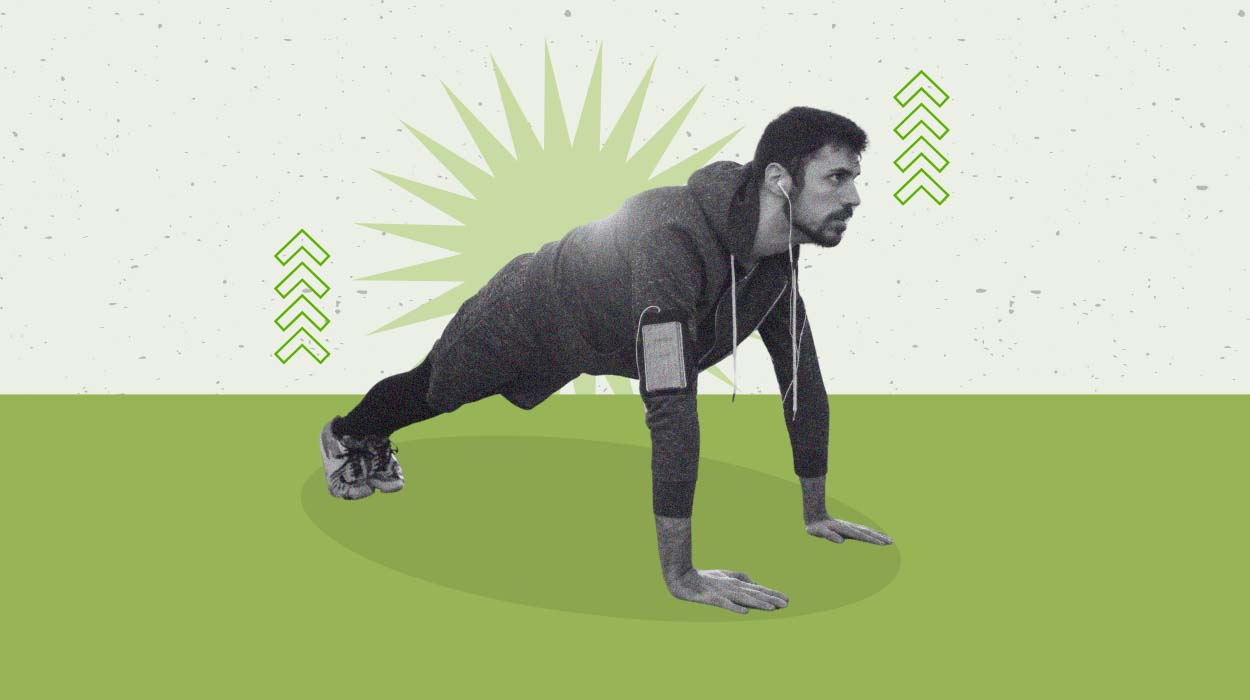
Sculpting the strong and well-defined physique of your dreams requires an effective workout routine. Of course, there are plenty of workout options out there, but push-day workouts have become extremely popular.
Why? These workout routines are specially designed to build muscle and strength and shed extra pounds when combined with proper nutrition plans.
In this article, we will explore everything you need to know about the push-day workout routine. This includes its benefits and tips for improving productivity during push exercises. We will also take a look at developing specific muscle groups and effective workouts for weight loss.
Whether you’re a novice or a pro lifter, an exceptional and effective push-day routine is essential for achieving your fitness goals, so let’s dive right in.
Push Day Workout Routine
The Push Day Workout Plan
A push-day workout routine specifically focuses on exercises that engage the push muscles of your upper body. Here’s a breakdown of the routine, including cool-down exercises.
Warm-Up
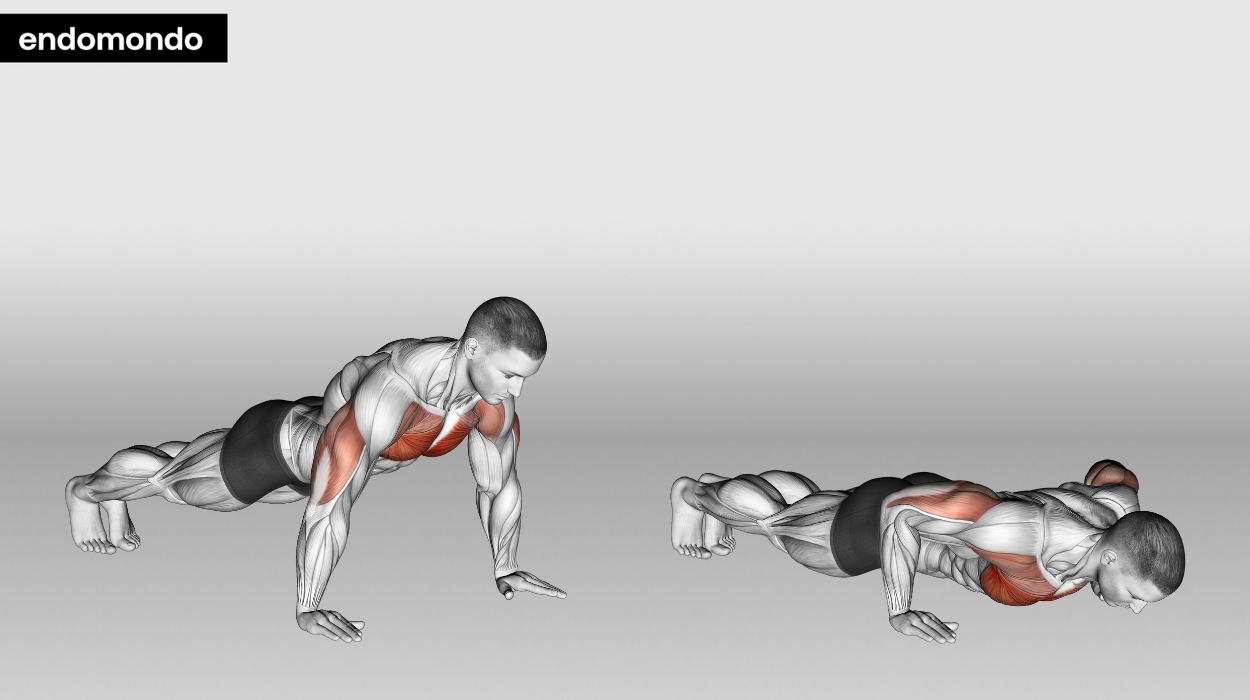
Kick-start your workout with about five to 10 minutes of light cardio. Activities such as cycling, push-ups, or jogging increase blood flow and warm up[1] your muscle groups.
It also prepares the body for the upcoming workout. You may find it helpful to include stretches for your shoulders, chest, and triceps during warm-ups.
Tips:
- Incorporate dynamic stretches[2] like arm circles, leg swings, and shoulder rotations to increase blood flow and prepare your muscles and joints for the push-up workout.
- Start with low-intensity warm-up exercises and gradually increase the intensity to avoid straining cold muscles.
- Pay special attention to areas involved in push-ups, such as the shoulders, chest, and wrists. Perform mobility exercises specific to these areas to enhance flexibility and range of motion, promoting optimal push-up form.
Bench Press
The bench press is a popular exercise that works on the muscle groups of your upper body. It is effective in chest muscle development, which can increase 10 to 20% in muscle thickness[3] over 3 months.
It also promotes the growth of the triceps. If you choose to focus on a single exercise to enhance your upper body muscles, the barbell bench press is a great choice.
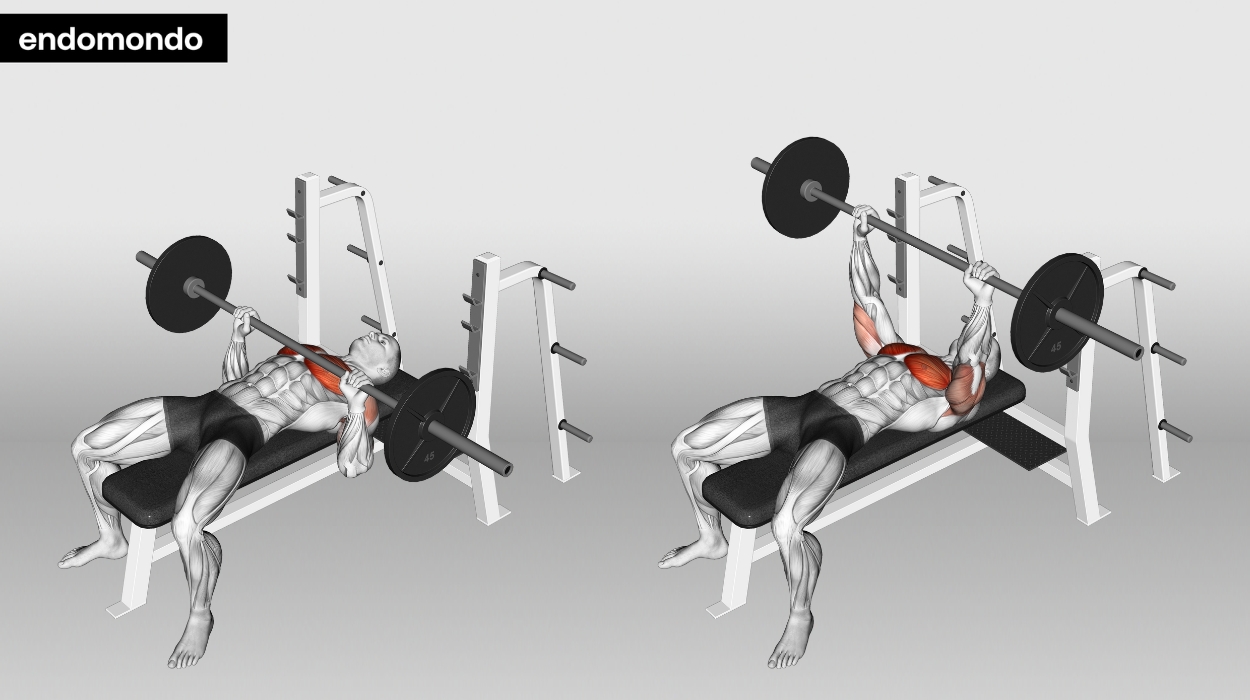
How to do:
- Lie down on the bench and pull your shoulder blades together.
- Slightly arch your back and grab the bar slightly wider than the width of your shoulder.
- Inhale and exhale to lift the bar from the rack.
- Lower the bar carefully until it touches your chest, close to your sternum.
- Push the bar to the starting position as you exhale.
- Repeat.
Tips:
- Ensure your back, shoulders, and buttocks remain in contact with the bench.
- Don’t allow your elbows to flare out to the sides as you lower the barbell.
- Exhale as you push the barbell up, and inhale as you lower it to your chest.
Optimal Sets and Reps: Three sets of 8-10 reps.
Overhead Press
Another classic exercise you should implement to develop your muscle groups is the overhead press. It typically works on your front and middle deltoids and triceps. Your entire body is also active during this exercise.
This overhead press enhances shoulder strength and definition, improving your push-up performance and overall upper-body power. Additionally, this exercise contributes to shoulder stability, reducing the risk of injury during push-up variations.
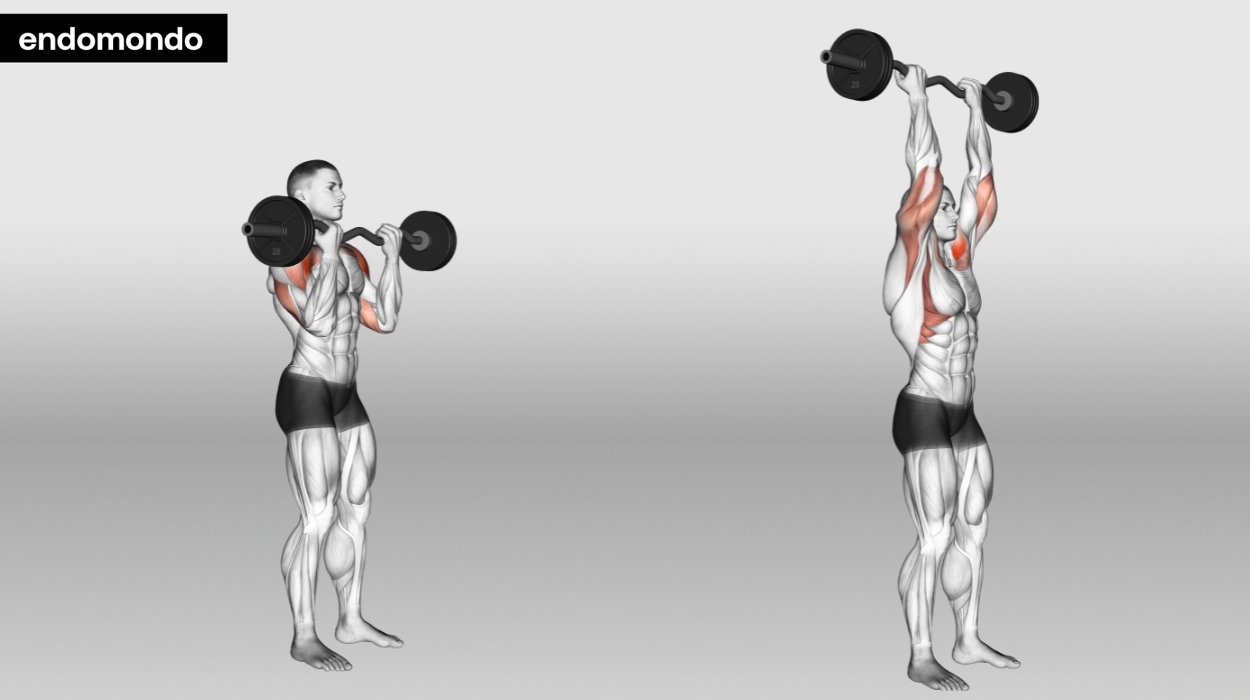
How to do:
- Place a barbell at about chest height.
- Grip the bar wider than shoulder width and step close to it.
- Inhale and raise the bar so it is resting on your collarbone.
- Press the bar up until your arms are straight while exhaling.
- Inhale at the top and lower the bar carefully to your shoulders.
- Repeat.
Tips:
- Maintain a strong and stable stance with your feet hip-width apart.
- Keep your core and glutes engaged throughout the exercise.
- Steer clear of using momentum or bouncing the weight to help lift it overhead.
Optimal Sets and Reps: Three sets of 8-10 repetitions
Incline Dumbbell Bench Press
The incline dumbbell bench press is another exercise that improves your upper body pushing muscles. It targets the upper chest muscles including the pectoralis major, shoulders including the anterior deltoids, and triceps.
Incorporating the incline bench press with dumbbells into your workout helps build and define the upper chest. It strengthens the shoulders and triceps, enhancing overall upper body strength.
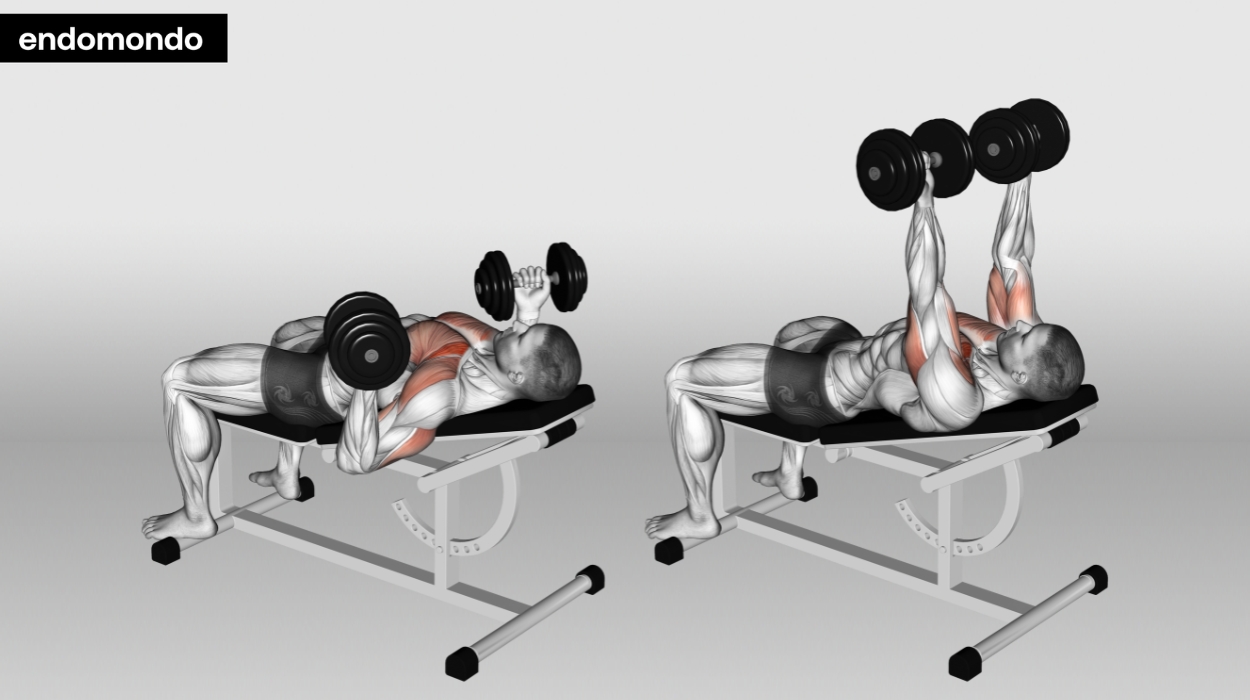
How to do:
- Adjust the incline of your bench to around 30-45 degrees.
- Sit down and lift a pair of dumbbells.
- Press the dumbbells from the starting position to up to straight arms while exhaling.
- Inhale while lowering the dumbbells to your shoulders.
- Repeat.
Tips:
- Maintain a neutral spine position by engaging your core and avoiding excessive arching.
- Start with a manageable weight and focus on maintaining proper form and control.
- Maintain a strong and steady grip on the dumbbells throughout the exercise.
Optimal Sets and Reps: Three sets of 8-10 reps.
Dumbbell Lateral Raise
One of the best upper body exercises to implement is lateral raises. It works on all of your shoulder muscle groups, primarily targeting the shoulder muscles, specifically the lateral deltoids.
The exercise enhances shoulder definition and widens the upper body appearance, creating a balanced physique. It also strengthens the shoulder muscles, improving overall shoulder stability and reducing the risk of injury.
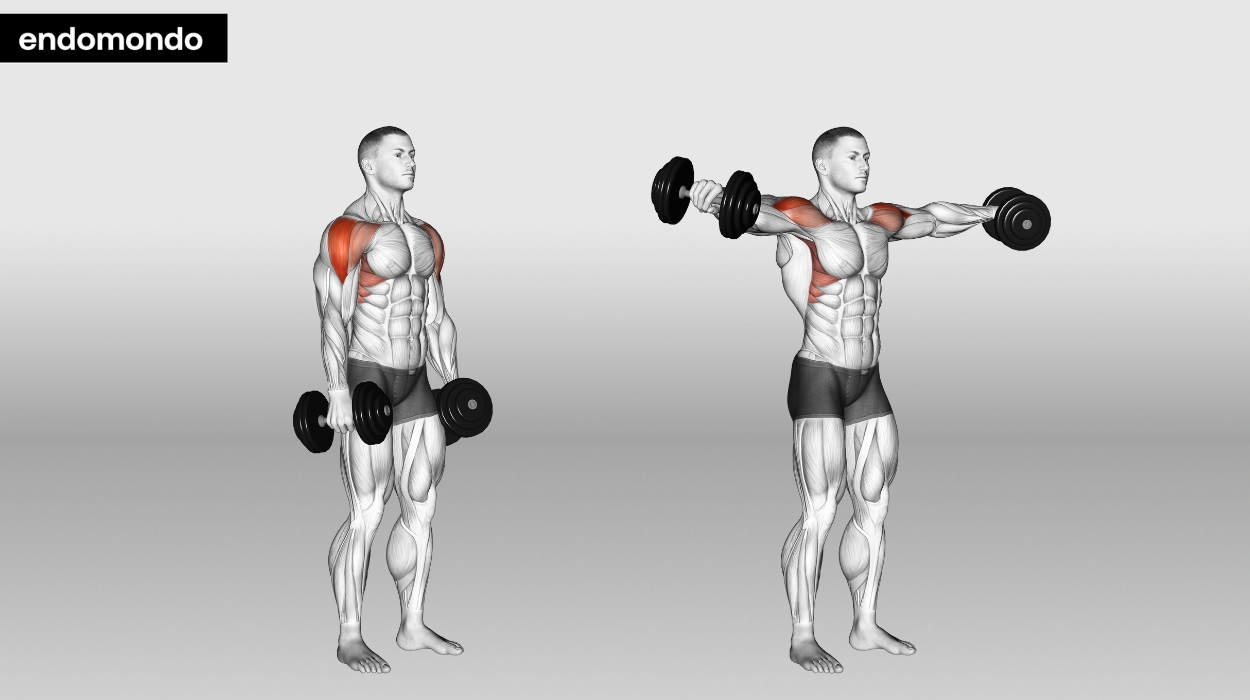
How to do:
- Grab a pair of dumbbells and place your arms on your sides.
- Gently raise the dumbbells outwards until your arms are straight and horizontal.
- Carefully lower the dumbbells.
- Repeat the action.
Tips:
- Avoid using momentum or swinging your body to lift the weights.
- Lower the dumbbells slowly and under control, resisting the urge to let them drop.
- Concentrate on feeling the tension in your lateral deltoids (side shoulder muscles) as you lift the dumbbells.
Optimal Sets and Reps: Three sets of 10-12 reps.
Dumbbell Chest Fly
The dumbbell chest fly is another push workout routine that results in a great pump. This isolation exercise primarily targets the chest muscles, specifically the pectoralis major.
This exercise helps build and define the chest muscles for a more sculpted upper body appearance. Also, it improves chest strength, which can enhance your performance in push-up variations, providing greater upper-body stability and power.
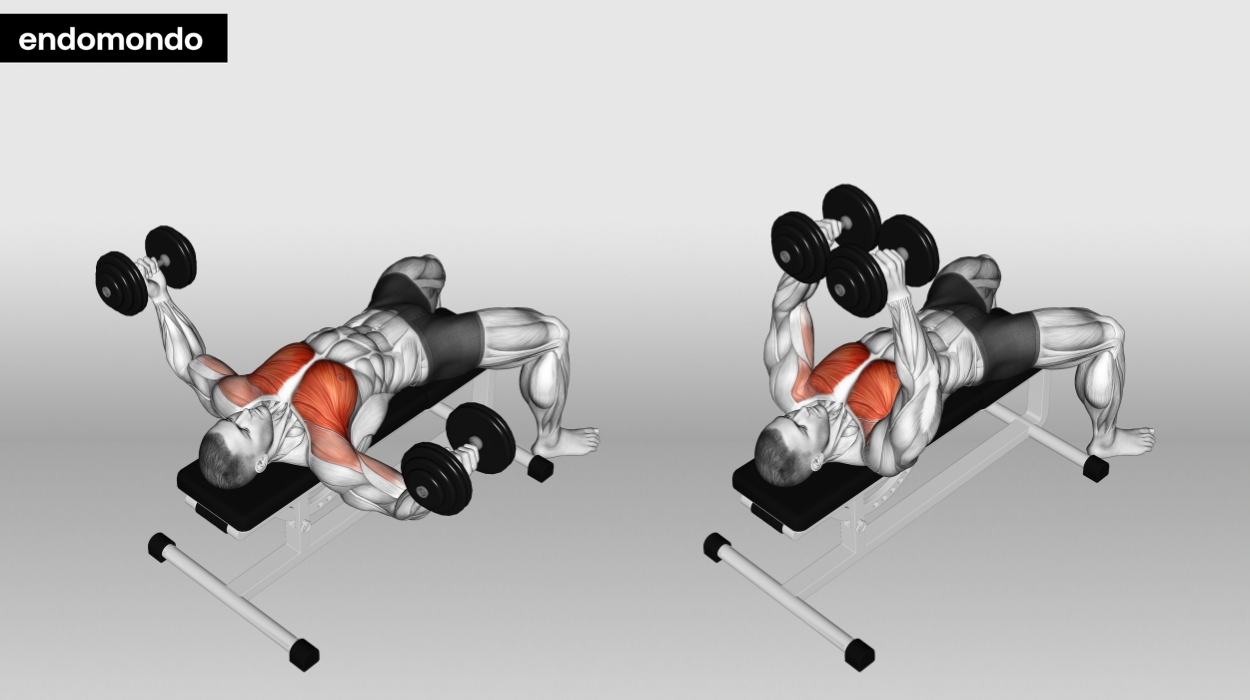
How to do:
- Lie down on a bench and lift a pair of dumbbells to the starting position, arms extended with dumbbells above your chest.
- With arms straight, lower the dumbbells to your sides.
- Reverse the motion and return the dumbbells to the starting position.
- Repeat.
Tips:
- Avoid using excessive weight, and focus on a controlled, slow, and smooth movement.
- Keep your elbows slightly bent and in line with your chest as you lower the dumbbells.
- Maintain a steady grip on the dumbbells and ensure they don’t touch or slam together during the exercise.
Optimal Sets and Reps: Three sets of 8-10 reps.
Barbell Lying Triceps Extension
The barbell lying triceps extension is the last push-pull workout to build your upper chest. It’s specially designed to work your triceps, lateral, and medial head.
Incorporating the barbell lying triceps extension into your push-up workout offers several benefits. It strengthens and sculpts the triceps, improving your ability to perform push-ups effectively. Moreover, strong triceps enhance upper body stability, allowing you to maintain proper form during push-up variations.
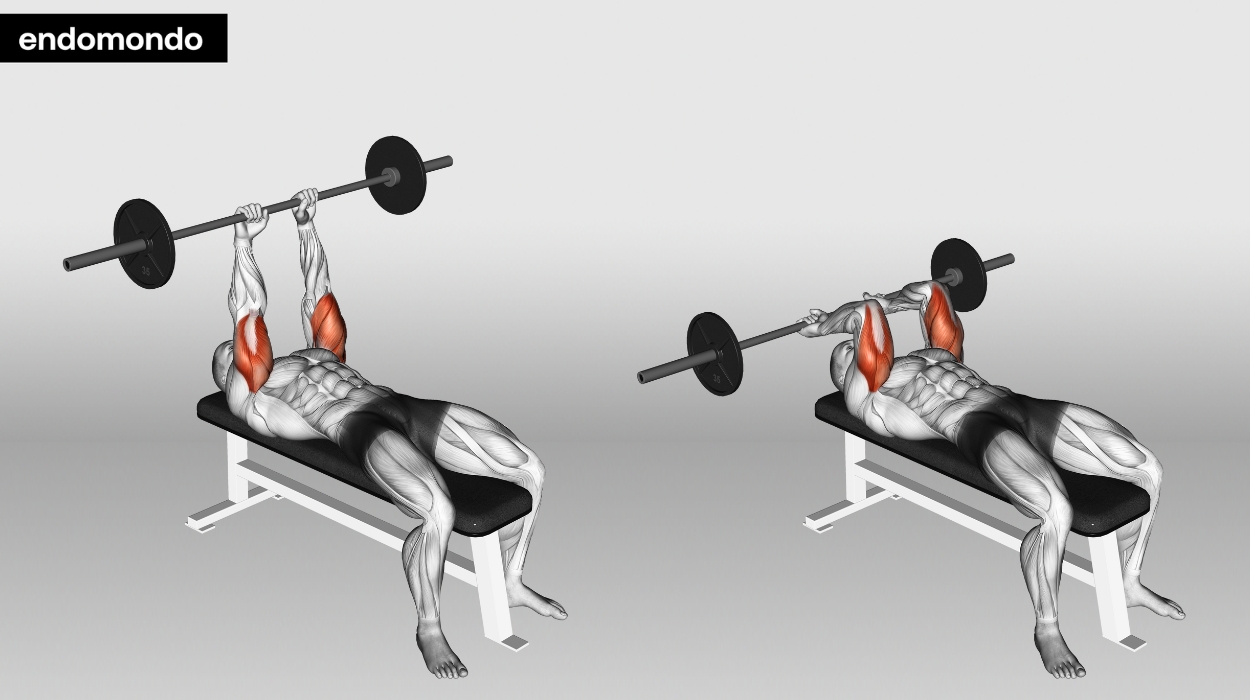
How to do:
- Lie down on a flat bench with your head near the edge.
- Grip a barbell and lift it over yourself with a straight arm.
- Lower the barbell behind your head as you exhale.
- Reverse the motion bringing the bar back over yourself while extending your arms again.
- Repeat.
Tips:
- Start with a manageable weight to maintain proper form and minimize the risk of injury.
- Ensure a secure grip on the barbell with your hands placed slightly narrower than shoulder-width apart.
- Aim to lower the barbell until it’s just above your forehead, and then extend it upward until your arms are fully extended.
Optimal Sets and Reps: Three sets of 8-10 reps.
Best Push-Day Workout Routine
The best push-day workout routine involves a mixture of compound and isolated movements that target the major muscle groups. Incorporating a routine that targets the chest, shoulders, and triceps is an effective way to create a productive push day.
Begin with the heavier, compound movements such as the bench press and overhead press first. This will engage multiple muscle groups simultaneously and help build strength. Once you have completed the compound movements, try shiting to isolated movements.
Examples of these exercises are lateral raises and dumbbell chest flies, which place a larger emphasis on the deltoids and pectoralis.
The frequency of workouts is important for optimizing muscle growth and overall performance. Recent literature supports that major muscle groups should be trained twice a week to maximize muscle growth.[4]
Remember to tailor the weight and repetitions to your fitness level and progressively challenge yourself. Gradually increase the weight and repetitions weekly or bimonthly to improve your load tolerance.
The sets and rep ranges below serve as a general guideline. However, you should be aiming to reach close to failure or within three to four reps from failure with each set.
For heavy compound movements, aim to rest for one to three minutes in between sets. For lighter, isolated exercises, 30 to 90 seconds is an appropriate range.
In addition to prioritizing rest, post-workout nutrition is essential. Ensure that your dietary intake supports your fitness goals. Adequate calories, macronutrients, and micronutrients contribute to sustained energy levels, enhanced performance, and protein synthesis for muscle growth.
Listen to your body’s cues, prioritize quality sleep, and adjust your routine as necessary.
| Exercise | Sets x Reps |
| Bench Press | 3 x 8-10 |
| Overhead Press | 3 x 8-10 |
| Incline Dumbbell Bench Press | 3 x 8-10 |
| Dumbbell Lateral Raise | 3 x 10-12 |
| Dumbbell Chest Fly | 3 x 8-10 |
| Barbell Lying Triceps Extension | 3 x 8-10 |
What Is A Push Day Workout Routine?
Push day workouts are special training sessions focusing on the upper body, primarily the chest, shoulders, and triceps. They are typically included in a split routine, where different major muscle groups are targeted on separate days. This is to ensure adequate recovery and muscle development.
A push-day workout routine aims to attain muscle growth and strength within specific areas of your body. Incorporating different compound movements can effectively help to achieve that goal. And in addition to building muscles, these workouts can aid in weight loss as well.
Muscles Worked In A Push Workout
During a push-day workout, two major muscle groups are targeted to develop strength and size in the upper body. The primary muscles worked in a typical push-day workout include:
Chest Muscles
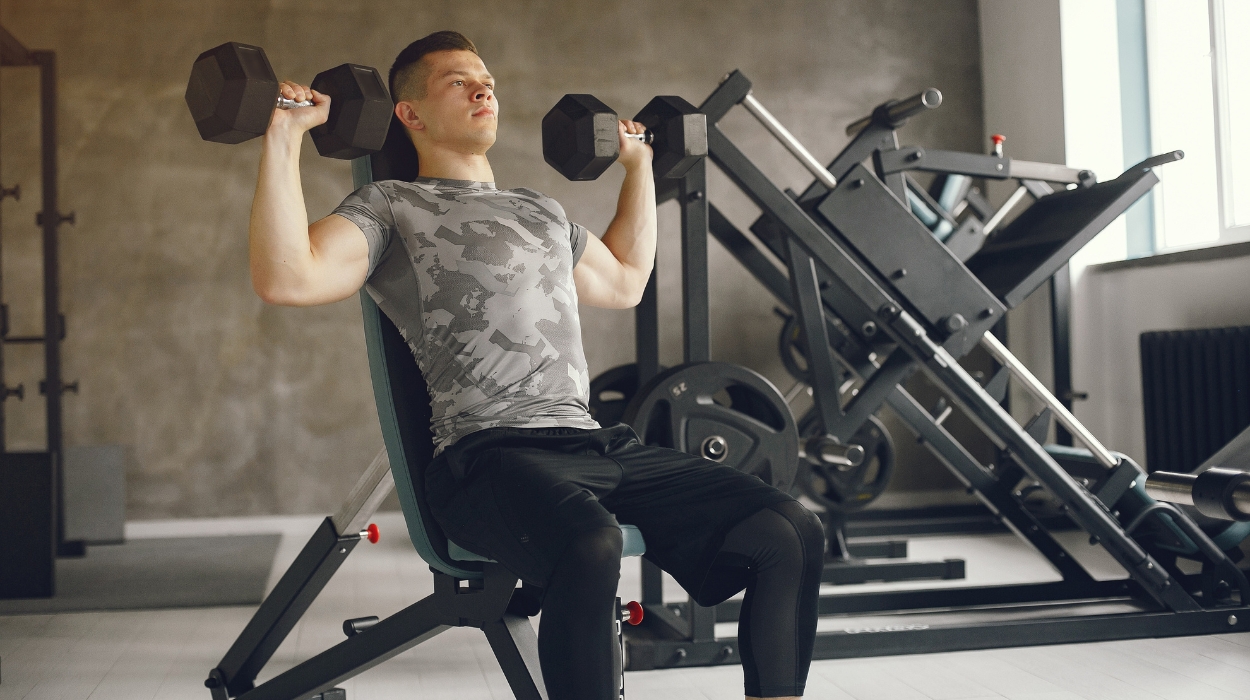
The chest muscles are composed of one large muscle on each side. The pecs[5] or pectoralis major are heavily engaged during these push workouts.
Muscle fibers from these areas connect to a single tendon that goes straight into your humerus (upper arms). The major function of your pecs is to bring your arm forward and toward your body. These actions are seen during a bench press or when you’re throwing a punch and balling your fists.
Shoulder Muscles
The shoulder muscles or deltoid muscles[6] feature three different sets of muscle fibers. They include the anterior delts, lateral delts, and posterior delts, or the front, side, and rear of your shoulders.
Only the lateral and front deltoids are included in a typical push-day workout. The rear deltoids are worked or trained during pull workouts.
Benefits Of Push Day Exercises
Push-day workout routines have several benefits for individuals looking to get chiseled and veiny arms, and they include the following:
Muscle Development
These workouts specifically target the muscles located in the chest, shoulders, and triceps. Engaging these muscles with exercises such as shoulder presses, bench presses, and tricep dips stimulates muscle development.
Enhanced Definition
These workouts also help build muscle mass and reduce subcutaneous fat (fat under the skin). This leads to better muscle definition. When your arms become more muscular through consistent training, your subcutaneous fat will reduce, giving you a chiseled look.
Strength And Functional Fitness
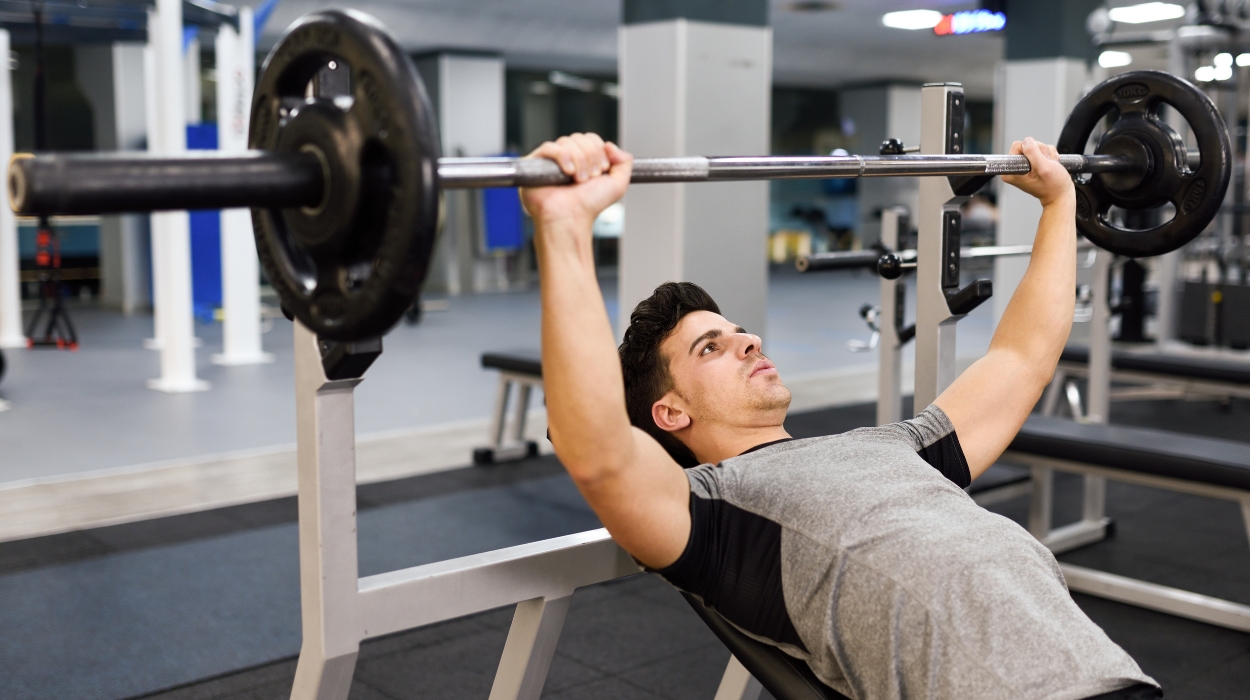
Push-day workouts involve exercises that require push movements. Performing these actions consistently can increase upper body strength and enhance your ability to perform tasks effortlessly.
Metabolic Boost
These workouts involve high-intensity activities that will elevate your heart rate and increase calorie burn. This significantly contributes to weight loss and improved metabolism – even after you have completed your workouts.
Increase Bone Density
Resistance training also contributes to increased bone density,[7] reducing the risk of osteoporosis. Osteoporosis[8] is a disease characterized by brittle/thin bones. Consistent resistance exercise can promote bone health and lower the risk of bone-related conditions.
Balanced Upper Body
These workouts help to create a balanced upper physique by developing the chest, shoulders, and triceps in proportion to other muscle groups. This development prevents muscle imbalances that may lead to postural injuries and other issues.
Incorporating push-day workouts in your daily routine, along with proper hydration and nutrition, will build your muscles, increase your strength, and keep you fit.
Tips For More Productive Push Workouts
To make your best pushing exercises more productive, try out the following:
- Plan your workouts and determine the exercises, reps, and sets to do in advance.
- Warm up before your exercises to prevent muscle soreness.
- Progressively increase the load placed on your muscles over time.
- Perform different training splits for your muscles separately.
- Rest adequately to allow time for recovery.
- Support your fitness goals with the best muscle-building supplements.
Following these tips can optimize workouts for muscle development and overall fitness.
Conclusion
A well-defined push-day workout routine is essential for targeting your upper body muscles and increasing strength and development.
By incorporating compound exercises and proper form, you can maximize the productivity of your push workouts. While muscle-building supplements can provide additional support, it is recommended to consult with a healthcare provider before you start taking anything.
Remember, with consistency and dedication, you can achieve your fitness goals.
Frequently Asked Questions
They primarily include the chest, shoulders, and triceps muscles.
Push-day workouts help build muscle, increase strength, enhance definition, and improve overall upper-body fitness.
They significantly contribute to weight loss by increasing metabolism and overall fitness.
It is vital in push-day workouts to target the intended muscles effectively.
Resources
- McGowan, C.J., Pyne, D.B., Thompson, K.G. and Rattray, B. (2015). Warm-Up Strategies for Sport and Exercise: Mechanisms and Applications. Sports Medicine, [online] 45(11), pp.1523–1546. doi:https://doi.org/10.1007/s40279-015-0376-x.
- Iwata, M., Yamamoto, A., Matsuo, S., Hatano, G., Miyazaki, M., Fukaya, T., Fujiwara, M., Asai, Y. and Suzuki, S. (2019). Dynamic Stretching Has Sustained Effects on Range of Motion and Passive Stiffness of the Hamstring Muscles. Journal of sports science & medicine, [online] 18(1), pp.13–20. Available at: https://www.ncbi.nlm.nih.gov/pmc/articles/PMC6370952/.
- Chaves (2020). Effects of Horizontal and Incline Bench Press on Neuromuscular Adaptations in Untrained Young Men. International journal of exercise science, [online] 13(6). Available at: https://pubmed.ncbi.nlm.nih.gov/32922646/.
- Schoenfeld, B.J., Ogborn, D. and Krieger, J.W. (2016). Effects of Resistance Training Frequency on Measures of Muscle Hypertrophy: A Systematic Review and Meta-Analysis. Sports Medicine, [online] 46(11), pp.1689–1697. doi:https://doi.org/10.1007/s40279-016-0543-8.
- Safarini, O.A. and Bordoni, B. (2023). Anatomy, Thorax, Ribs. [online] Nih.gov. Available at: https://www.ncbi.nlm.nih.gov/books/NBK538328/.
- Elzanie A;Varacallo M (2024). Anatomy, Shoulder and Upper Limb, Deltoid Muscle. [online] Available at: https://pubmed.ncbi.nlm.nih.gov/30725741/.
- A Ram Hong and Sang Wan Kim (2018). Effects of Resistance Exercise on Bone Health. Endocrinology and Metabolism, [online] 33(4), pp.435–435. doi:https://doi.org/10.3803/enm.2018.33.4.435.
- Porter JL;Varacallo M (2023). Osteoporosis. [online] Available at: https://pubmed.ncbi.nlm.nih.gov/28722930/.




